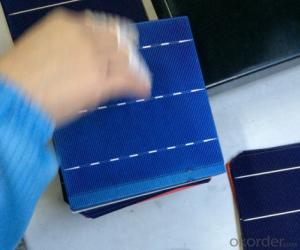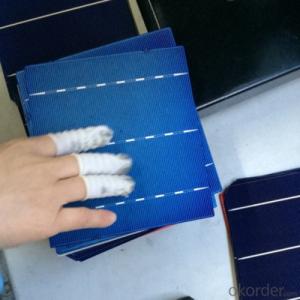Poly 3BB 4BB Solar Cells with Low Price 156*156mm
- Loading Port:
- Shanghai
- Payment Terms:
- TT or LC
- Min Order Qty:
- 30000 pc
- Supply Capability:
- 3000000 pc/month
OKorder Service Pledge
OKorder Financial Service
You Might Also Like
Product description
Poly Solar Cells 156*156mm B Grade Low Price 3BB 4BB
A solar cell, or photovoltaic cell, is an electrical device that converts the energy of light directly into electricity by the photovoltaic effect, which is a physical and chemical phenomenon.[1] It is a form of photoelectric cell, defined as a device whose electrical characteristics, such as current, voltage, or resistance, vary when exposed to light. Solar cells are the building blocks of photovoltaic modules, otherwise known as solar panels.
Solar cells are described as being photovoltaic irrespective of whether the source is sunlight or an artificial light. They are used as a photodetector (for example infrared detectors), detecting light or other electromagnetic radiation near the visible range, or measuring light intensity.
In contrast, a solar thermal collector supplies heat by absorbing sunlight, for the purpose of either direct heating or indirect electrical power generation from heat. A "photoelectrolytic cell" (photoelectrochemical cell), on the other hand, refers either to a type of photovoltaic cell (like that developed by Edmond Becquerel and modern dye-sensitized solar cells), or to a device that splits water directly into hydrogen and oxygen using only solar illumination.
Advantage Of Poly Solar Cell 4BB 3BB
1: High quality cell, Level B cell (14%—17.5%)
2.Dimensione:156*156mm Diagonal:200mm
3: Qualified certification: TUV,CE certification.
4: Warranty: five years for whole unit
Usage/Application Of Poly Solar Cell 4BB 3BB
1.The absorption of light, generating either electron-hole pairs or excitons.
2.The separation of charge carriers of opposite types.
3.The separate extraction of those carriers to an external circuit.
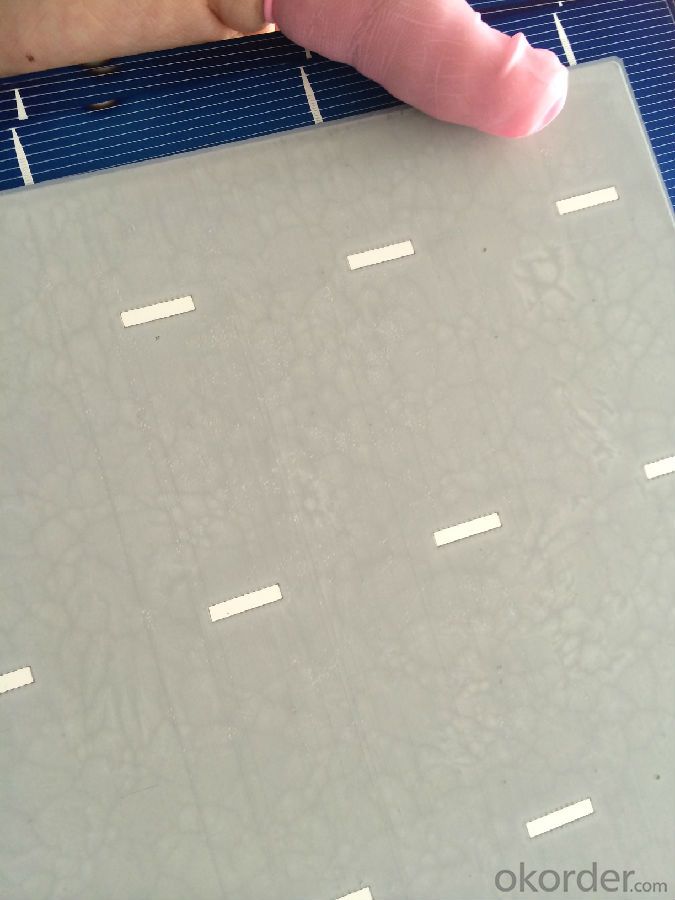
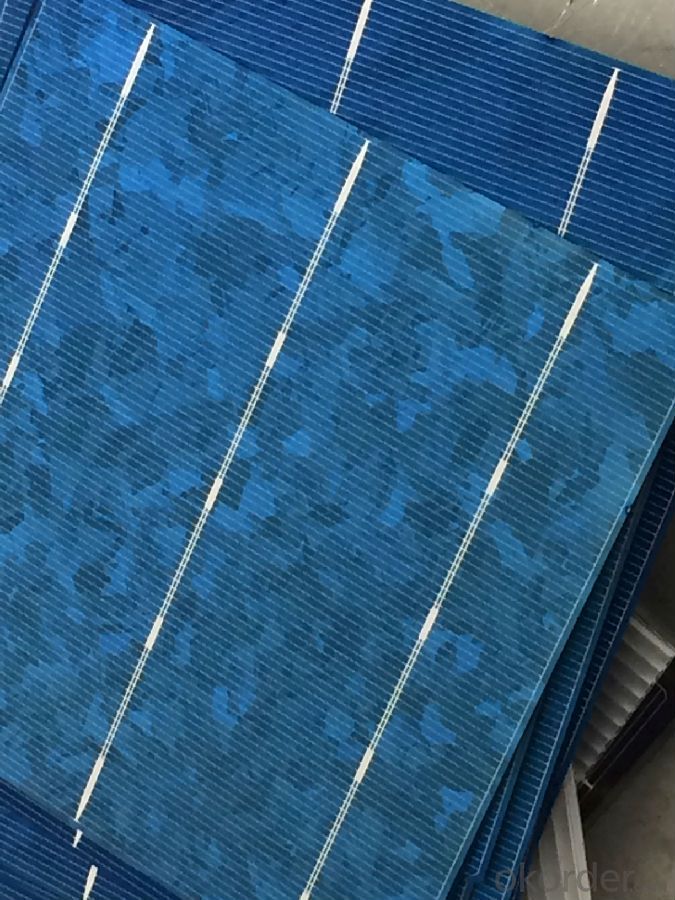
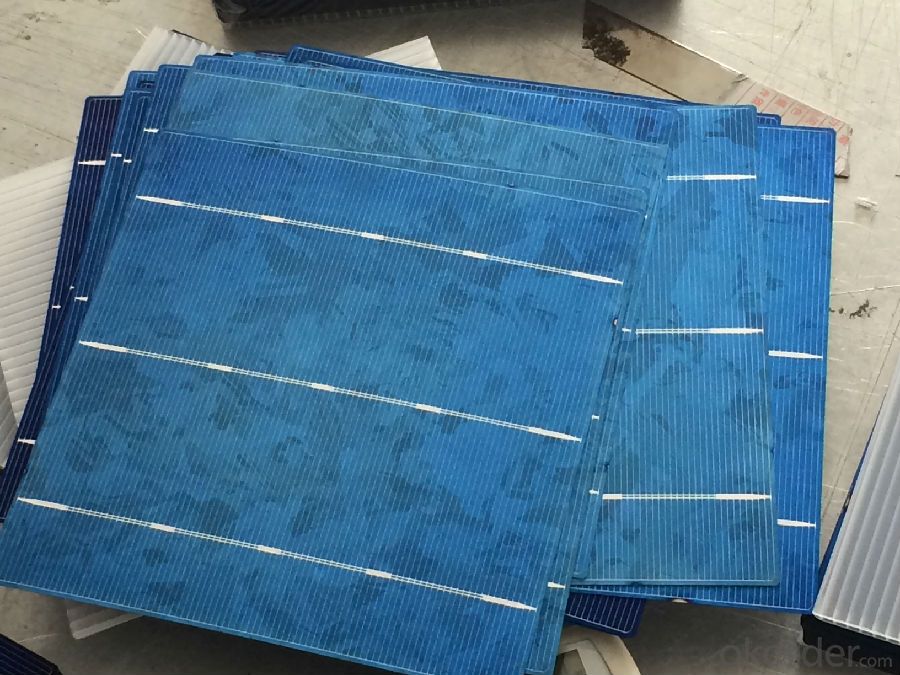
Electrical Characteristic
Efficiency (%) | Pmpp (W) | Umpp (V) | Impp (A) | Uoc (V) | Isc (A) | FF (%) |
17.25 | 4.197 | 0.524 | 7.992 | 0.62 | 8.458 | 80.03% |
17 | 4.137 | 0.524 | 7.876 | 0.619 | 8.353 | 80.01% |
16.75 | 4.076 | 0.522 | 7.81 | 0.617 | 8.286 | 79.73% |
16.5 | 4.015 | 0.518 | 7.746 | 0.613 | 8.215 | 79.73 |
16.25 | 3.955 | 0.515 | 7.683 | 0.61 | 8.144 | 79.61% |
16 | 3.894 | 0.512 | 7.613 | 0.608 | 8.075 | 79.31% |
15.75 | 3.833 | 0.51 | 7.534 | 0.605 | 8.058 | 78.62% |
15.5 | 3.772 | 0.508 | 7.453 | 0.604 | 8.02 | 77.87% |
15.25 | 3.771 | 0.505 | 7.35 | 0.604 | 9.997 | 76.83% |
15 | 3.65 | 0.503 | 7.271 | 0.604 | 7.989 | 75.64% |
14.5 | 3.529 | 0.499 | 7.067 | 0.604 | 7.988 | 73.14% |
14 | 3.407 | 0.499 | 6.833 | 0.604 | 7.833 | 72.01% |
Intensity Dependence
Intensity [W/m2] | Isc× [mA] | Voc× [mV] |
1000 | 1.00 | 1.000 |
900 | 0.90 | 0.989 |
500 | 0.50 | 0.963 |
300 | 0.30 | 0.939 |
200 | 0.20 | 0.920 |
Packaging & Delivery Of Poly Solar Cell 156mm | |
Packaging Detai | Packaging Detail:Export Carton and Pallet or under customer request. |
Delivery Detail:10-20days | |
FAQ
Q:What price for each watt?
A:It depends on the quantity, delivery date and payment terms
Q:What is your warranty system?
A:Our Solar cells performance guarantees for 25 years
Q:How do you pack your products?
A:We have rich experience on how to pack thecells to make sure the safety on shipment when it arrives at the destination.
Brief introduction of 4bb solar cell
4bb solar cells through the photoelectric effect or photochemical effect directly convert light into electrical energy, which makes use of the photoelectric conversion principle of solar radiation through the semiconductor material electrical energy transformed into a device; the photoelectric conversion process is usually called "photovoltaic hit "affect, therefore, solar cells, also known as" photovoltaic cells.
Working principle of 4bb solar cell
Foundation of working principle of 4bb solar cell is the "photovoltaic" effect semiconductor PN junction. The so-called photovoltaic effect, simply put, is that when the object is exposed to light, its charge distribution in vivo to produce an effect of EMF and current changes. In gases, liquids and solids can produce this effect, but in solid, especially in the semiconductor, solar energy is converted to electrical energy efficiency is particularly high, so the semiconductor photoelectric effect aroused special attention, the most studied, and invention of manufacturing a semiconductor solar cells.
When sun lights PN junction, the electrons in the semiconductor due to the availability of light energy and release electrons, and accordingly will produce electron - hole pairs, and the role of the barrier electric field, electrons are driven to the N-type region, holes are driven to the P-type region so that the region has a surplus of electrons N, P region has excess holes; so in the vicinity of the PN junction formed with the barrier electric field in the opposite direction of photo-generated electric field. Light green part of the field of offset barrier electric field, the rest of the P-type region is positively charged, N-type region is negatively charged; so he makes the force N region and a thin layer of P zone between the generation, namely "photovoltaic" electromotive force. When the external circuit is turned on, there will be power output.
This is the basic principle of the PN junction contact silicon 4bb solar cell power generation. If the dozens, hundreds of solar cells in series, in parallel become encapsulated solar cell module in the sunlight irradiation, the power can be obtained with a certain power output

- Q:How do solar cells handle power fluctuations?
- Solar cells handle power fluctuations through a process called maximum power point tracking (MPPT), which optimizes the output power of the cell. MPPT algorithms continuously monitor the voltage and current of the solar cell and adjust the load resistance to ensure that the cell operates at its maximum power point, even in the presence of fluctuations in solar irradiance or temperature. This allows solar cells to efficiently convert sunlight into electricity and adapt to changing environmental conditions.
- Q:How are solar cells used in calculators?
- Solar cells are used in calculators to convert sunlight into electrical energy. This energy is then used to power the calculator, eliminating the need for batteries or other external power sources.
- Q:How do solar cells handle shading or obstructions?
- Solar cells are designed to handle shading or obstructions by employing bypass diodes. These diodes allow the current to bypass the shaded or obstructed areas, preventing them from affecting the overall performance of the solar cell.
- Q:Can solar cells be used in recreational vehicles?
- Yes, solar cells can be used in recreational vehicles. They are a popular and effective solution for powering various systems in RVs including lighting, appliances, and electronics. Solar panels can be mounted on the roof of an RV to harness sunlight and convert it into electricity, providing a reliable and sustainable source of power while on the road or during camping trips. Additionally, solar cells offer the advantage of being environmentally friendly and reducing reliance on traditional energy sources.
- Q:Can solar cells be used in disaster recovery efforts?
- Yes, solar cells can be used in disaster recovery efforts. They are a reliable and sustainable source of energy that can provide electricity to power essential devices and equipment in disaster-stricken areas. Solar cells can be used to charge communication devices, provide lighting, run medical equipment, and support temporary shelters. Their portability and ability to operate off-grid make them particularly valuable in situations where traditional power sources are disrupted or inaccessible. Additionally, solar cells can contribute to reducing the reliance on fossil fuels during recovery efforts, promoting a cleaner and more sustainable path towards rebuilding communities affected by disasters.
- Q:What factors affect the efficiency of solar cells?
- Several factors can affect the efficiency of solar cells. The first is the quality and type of materials used in the cell's construction. High-quality and advanced materials tend to have higher conversion efficiencies. The second factor is the amount and intensity of sunlight received by the solar cell. More sunlight and higher intensity can increase the energy output. Additionally, the temperature of the cell also plays a role, as high temperatures can reduce efficiency. Finally, the design and structure of the solar cell, including the arrangement of layers and the surface area, can impact its efficiency.
- Q:Can solar cells work in cloudy weather?
- Yes, solar cells can still work in cloudy weather, although their efficiency may be reduced. Clouds diffuse sunlight, causing a decrease in the amount of direct sunlight reaching the solar cells. However, solar cells can still generate electricity from the diffused sunlight, although at a lower rate compared to sunny conditions.
- Q:Can solar cells be used for cooking?
- Yes, solar cells can be used for cooking. Solar cookers are designed to capture and convert sunlight into heat energy, which can then be used for cooking food. These cookers utilize solar cells to generate electricity, which can power electric stoves or ovens for cooking. Additionally, some solar cookers directly convert sunlight into heat using reflective surfaces and insulation, eliminating the need for electricity altogether.
- Q:Can solar cells be used to power wireless communication networks?
- Yes, solar cells can be used to power wireless communication networks. Solar cells are capable of converting sunlight into electricity, which can be stored in batteries or directly used to power various devices, including wireless communication equipment. This renewable energy source offers a sustainable and environmentally friendly solution for powering wireless networks in remote or off-grid locations. Additionally, advancements in solar cell technology have made them more efficient and cost-effective, making them a viable option for powering these networks.
- Q:How do solar cells perform in polluted environments?
- Solar cells can still function effectively in polluted environments, although their performance may be slightly reduced. The presence of air pollution, such as smog or particulate matter, can block or scatter sunlight, resulting in a decrease in the amount of energy captured by the solar cells. Additionally, the accumulation of dust and dirt on the surface of the cells can further diminish their efficiency. Therefore, regular cleaning and maintenance are important to optimize the performance of solar cells in polluted environments.
1. Manufacturer Overview |
|
|---|---|
| Location | |
| Year Established | |
| Annual Output Value | |
| Main Markets | |
| Company Certifications | |
2. Manufacturer Certificates |
|
|---|---|
| a) Certification Name | |
| Range | |
| Reference | |
| Validity Period | |
3. Manufacturer Capability |
|
|---|---|
| a)Trade Capacity | |
| Nearest Port | |
| Export Percentage | |
| No.of Employees in Trade Department | |
| Language Spoken: | |
| b)Factory Information | |
| Factory Size: | |
| No. of Production Lines | |
| Contract Manufacturing | |
| Product Price Range | |
Send your message to us
Poly 3BB 4BB Solar Cells with Low Price 156*156mm
- Loading Port:
- Shanghai
- Payment Terms:
- TT or LC
- Min Order Qty:
- 30000 pc
- Supply Capability:
- 3000000 pc/month
OKorder Service Pledge
OKorder Financial Service
Similar products
New products
Hot products
Related keywords

